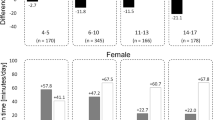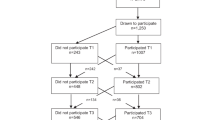Abstract
Depending upon age, gender and geographical area, 3–20% of the children and young adolescents in Switzerland are overweight and 0–6% obese, using the criteria of the International Obesity Task Force. The most likely explanation for this increasing prevalence of overweight and obesity is a decline in physical activity, and hence diminished energy expenditure that is not matched by a corresponding reduction in energy intake. In this paper, we first review the epidemiological situation in Switzerland regarding the rising prevalence of obesity and the decline in physical activity, and then focus upon the environmental, social and cultural factors that predispose children to sedentary behaviours. Several of these socio-cultural factors and in particular television viewing and poor-parental model, confer early ‘learned behaviours’ for low physical activity which track throughout growth into adulthood, and which also predispose to the overconsumption of less healthy foods. It is time to focus on preventive strategies directed at curtailing these ‘learned behaviours’, that we have acquired during the transition from the stone-age to the chip-age, if we want to hold the current pandemic of obesity.
This is a preview of subscription content, access via your institution
Access options
Subscribe to this journal
Receive 12 print issues and online access
$259.00 per year
only $21.58 per issue
Buy this article
- Purchase on Springer Link
- Instant access to full article PDF
Prices may be subject to local taxes which are calculated during checkout


Similar content being viewed by others
References
Moller DE, Kaufman KD . Metabolic syndrome: a clinical and molecular perspective. Annu Rev Med 2005; 56: 45–62.
Pate RP, Baranowski T, Dowda M, Trost SG . Tracking of physical activity in young children. Med Sci Sports Exerc 1996; 28: 92–96.
Suter PM, Schutz Y . Prevalence of obesity in adults. In: Eichholzer M, Camenzind-Frey E, Matzje A et al. (eds). Fünfter Schweizerischer Ernährungsbericht. Bern: Bundesamt für Gesundheit, 2005, pp 471–492 (article in German).
Suter PM . Nutrition, lifestyle and obesity in children and adolescents in Switzerland (Ernährung, lifestyle und adipositas von kindern und jugendlichen in der Schweiz). In: Eichholzer M, E C-F, Matzke Aea (eds). Fünfter Schweizerischer Ernährungsbericht. Bern: Bundesamt für Gesundheit, 2005, pp 167–198.
Suter PM . Nutrition, lifestyle and obesity in children and adolescents in Switzerland. In: Eichholzer M, Camenzind-Frey E, Matzje A et al (eds). Fünfter Schweizerischer Ernährungsbericht. Bundesamt für Gesundheit: Bern, 2005, pp 617–198 (article in German).
Bettoni M . Prevalence and determinants of overweight and obesity in 9–12 year old children in Ticino. (Prävalenz und Determinanten des Übergewichtes und der Adipositas bei 9–12 jährigen Primarschülern im Tessin). PhD dissertation, Department of Medicine, University Hospital Zurich, 2002, pp 1–61.
Groscurth A, Vetter W, Suter PM . Is the Swiss population gaining body weight? Body mass index in insurance applications between 1950 and 1990. Schweiz Rundsch Med Prax 2003; 92: 2191–2200.
Lamprecht M, Stamm HP . Observation in sport and movement in Switzerland (Observatorium sport und bewegung Schweiz Jahresbericht), 2004. (DownloadFile.tmp/SPORTOBS_Zwischenbericht04.pdf) http://www.baspo.admin.ch/internet/baspo/de/home/wissen00/wissen00f/wissen00f2.Par.00.
Wiegand D, Bignasca N . Five hundred and fifty in action: move (Fünfhundertfünfzigtausend in action: move). Fachzeitschrift für sport 2005; 4: 16–19.
Lamprecht M, Stamm H . Swiss observation for sport and physical activity sports (Sozialforschung und Beratung AG). (Download File.tmp/SPORTOBS_Zwischenbericht04.pdf): 2004, pp 1–51, http://www.baspo.admin.ch/internet/baspo/de/home/wissen00/wissen00f/wissen00f2.Par.00.
Brownson RC, Boehmer TK, Luke DA . Declining rates of physical activity in the United States: what are the contributors? Annu Rev Public Health 2005; 26: 421–443.
Frank LD, Andersen MA, Schmid TL . Obesity relationships with community design, physical activity, and time spent in cars. Am J Prev Med 2004; 27: 87–96.
Braza M, Shoemaker W, Seeley A . Neighborhood design and rates of walking and biking to elementary school in 34 California communities. Am J Health Promot 2004; 19: 128–136.
Lanningham-Foster L, Nysse LJ, Levine JA . Labor saved, calories lost: the energetic impact of domestic labor-saving devices. Obes Res 2003; 11: 1178–1181.
Lopez R . Urban sprawl and risk for being overweight or obese. Am J Public Health 2004; 94: 1574–1579.
Bell AC, Ge K, Popkin BM . The road to obesity or the path to prevention: motorized transportation and obesity in China. Obes Res 2002; 10: 277–283.
Robinson TN . Television viewing and childhood obesity. Pediatr Clin North Am 2001; 48: 1017–1025.
Gortmaker SL, Must A, Sobol AM, Peterson K, Colditz GA, Dietz WH . Television viewing as a cause of increasing obesity among children in the United States, 1986–1990. Arch Pediatr Adolesc Med 1996; 150: 356–362.
Signer TM . TV consumption and physical activity: a risk factor for overweight among primary school children in Zurich (TV-Konsum und körperliche Inaktivität: Ein Risikofaktor für Übergewicht bei Zürcher Primarschülern) (Download File.tmp/SPORTOBS_Zwischenbericht04.pdf). PhD dissertation, Department of Medicine, University Hospital Zurich, 1999.
Stettler N, Signer TM, Suter PM . Electronic games and environmental factors associated with childhood obesity in Switzerland. Obes Res 2004; 12: 896–903.
Saelens BE, Sallis JF, Nader PR, Broyles SL, Berry CC, Taras HL . Home environmental influences on children's television watching from early to middle childhood. J Dev Behav Pediatr 2002; 23: 127–132.
Baumann B . Physical Activity in children, their parents and their siblings. PhD dissertation, Department of Medicine, University Hospital Zurich, 2005.
Chen C, Bazan NG . Lipid signaling: sleep, synaptic plasticity, and neuroprotection. Prostaglandins Other Lipid Mediat 2005; 77: 65–76.
Durmer JS, Dinges DF . Neurocognitive consequences of sleep deprivation. Semin Neurol 2005; 25: 117–129.
Yang C-K, Kim JK, Patel SR, Lee J-H . Age-related changes in sleep/wake patterns among korean teenagers. Pediatrics 2005; 115: 250–256.
Carskadon MA . Sleep difficulties in young people. Arch Pediatr Adolesc Med 2004; 158: 597–598.
Liu X, Liu L, Owens JA, Kaplan DL . Sleep patterns and sleep problems among schoolchildren in the United States and China. Pediatrics 2005; 115: 241–249.
Tagaya H, Uchiyama M, Ohida . Sleep habits and factors associated with short sleep duration among Japanese high-school students: a community study. Sleep and Biol Rhythms 2004; 2: 57–64.
Vorona RD, Winn MP, Babineau TW, Eng BP, Feldman HR, Ware JC . Overweight and obese patients in a primary care population report less sleep than patients with a normal body mass index. Arch Intern Med 2005; 165: 25–30.
Shigeta H, Shigeta M, Nakazawa A, Nakamura N, Yoshikawa T . Lifestyle, obesity, and insulin resistance. Diabetes Care 2001; 24: 608.
Sekine M, Yamagami T, Handa K et al. A dose–response relationship between short sleeping hours and childhood obesity: results of the Toyama Birth Cohort Study. Child: Care, Health Dev 2002; 28: 163–170.
Nilsson JP, Sonderstrom M, Karlson AU et al. Less effective executive functioning after one night's sleep deprivation. J Sleep Res 2005; 14: 1–6.
Dahl RE . The impact of inadequate sleep on children's daytime cognitive function. Semin Pediatr Neurol 1996; 3: 44–50.
Spiegel K, Tasali E, Penev P, Cauter EV . Sleep curtailment in healthy young men is associated with decreased leptin levels, elevated ghrelin levels, and increased hunger and appetite. Ann Intern Med 2004; 141: 846–850.
St-Pierre DH, Karelis AD, Cianflone K et al. Relationship between ghrelin and energy expenditure in healthy young women. J Clin Endocrinol Metab 2004; 89: 5993–5997.
Levine JA, Eberhardt NL, Jensen MD . Role of nonexercise activity thermogenesis in resistance to fat gain in humans. Science 1999; 283: 212–214.
Levine JA, Lanningham-Foster LM, McCrady SK, Krizan AC, Olson LR, Kane PH et al. Interindividual variation in posture allocation: possible role in human obesity. Science 2005; 307: 584–586.
Levine JA, Kotz CM . NEAT – non-exercise activity thermogenesis – egocentric & geocentric environmental factors vs biological regulation. Acta Physiol Scand 2005; 184: 309–318.
Chakravarthy MV, Booth FW . Eating, exercise, and ‘thrifty’ genotypes: connecting the dots toward an evolutionary understanding of modern chronic diseases. J Appl Physiol 2004; 96: 3–10.
Zilversmit DB . Atherogenic nature of triglycerides, postprandial lipidemia, and triglyceride-rich lipoproteins. Clin Chem 1995; 41: 153–158.
Suter PM, Gerritsen-Zehnder M, Hasler E, Gurtler M, Vetter W, Hanseler E . Effect of alcohol on postprandial lipemia with and without preprandial exercise. J Am Coll Nutr 2001; 20: 58–64.
Linn SE . Food marketing to children in the context of a marketing maelstrom. J Public Health Policy 2004; 25: 376–378.
Sudakov KV . ‘Imprints of reality’ in the systems mechanisms of brain activity. Neurosci Behav Physiol 2001; 31: 561–571.
McClure SM, Li J, Tomlin D, Cypert KS, Montague LM, Montague PR . Neural correlates of behavioral preference for culturally familiar drinks. Neuron 2004; 44: 379–387.
Anonymous. Neuromarketing: beyong branding. Lancet Neurol 2004; 3: 71.
Ludwig DS, Gortmaker SL . Programming obesity in childhood. Lancet 2004; 364: 226–227.
Author information
Authors and Affiliations
Corresponding author
Rights and permissions
About this article
Cite this article
Suter, P., Ruckstuhl, N. Obesity during growth in Switzerland: role of early socio-cultural factors favouring sedentary activities. Int J Obes 30 (Suppl 4), S4–S10 (2006). https://doi.org/10.1038/sj.ijo.0803513
Published:
Issue Date:
DOI: https://doi.org/10.1038/sj.ijo.0803513



